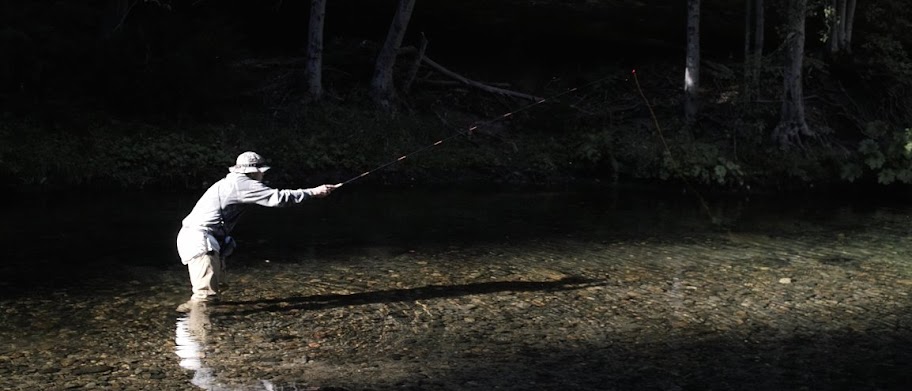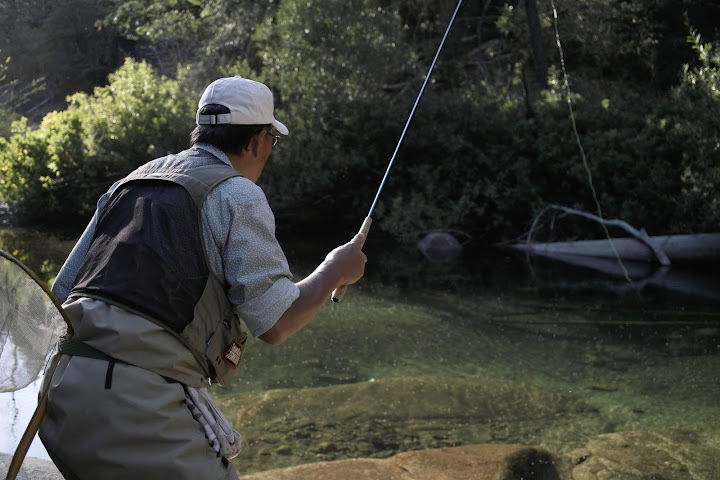Archive for the ‘About Tenkara’ Category
Pictures of tenkara fishing in Japan… and some Japanese terms for you
Tomorrow morning I’m headed for a 2-day tenkara event, and next week my schedule is packed. I hope to write more soon, but thought I’d leave you with a post of fishing before I go. This time I want to also share a few Japanese terms for specific types of stream, or terms that I use very often to figure out where to go fishing. Like the often cited example of eskimos have 30 words for different types of snow, the Japanese culture also developed a good vocabulary for describing their streams. To complete the post, I’ll include a couple of my best fish shots so far.
Japan has streams of many different kinds. The general term for river is “kawa“, but there are other more specific terms to describe different streams. Kawa can be “honryu“, which is the main stream, or “shiryu“, which are tributaries. Of course, a shiryu can also have other shiryus… Two other terms I use very often are “karyu“, which means downstream, or “jiuryu“, which means upstream.
Some are small, boulder strewn mossy streams. These are normally called “sawa“, the term for small streams, such as the one Yoshikazu Fujioka-san is fishing below, and my host Ikumi is fishing below that. I’ve been teaching Ikumi tenkara fishing and am very proud of how good her form is. We’ve only been out 3 times and her casting precision and technique impress me. She caught a fish on this evening (yumazume = evening activity period), Rocky and I didn’t.
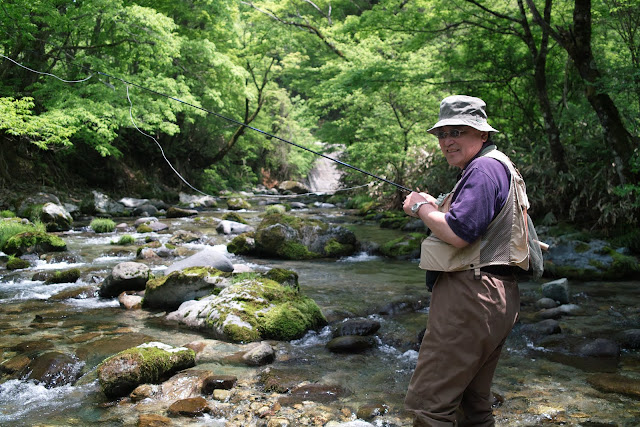

Mountain streams in general are called “keiryu”.
The keiryu below is being worked by Chris Stewart, the “Tenkara Bum”, who is referred by our Japanese friends as “tenkara baka”, though we’re still unsure that’s the best term for a bum. This was the “shiryu” to the Itoshiro, which is the “honryu” in the area we fished and one of the few catch and release streams in the country.

Keiryu also come in different styles. The clearest ones are called “seiryu”, which indicates they are “clear/beautiful/moving water types of streams. They may be large or small, but have the characteristic features of a mountain stream, boulders/pockets/currents. The Mazegawa is referred to as a seiryu. The Mazegawa has at least 100 distinct parts, that feel like entirely different streams. The one picture below shows my hosts, Ikumi on the foreground and Rocky farther downstream. The pool in front of her is about 12ft deep and we could easily see every rock below.
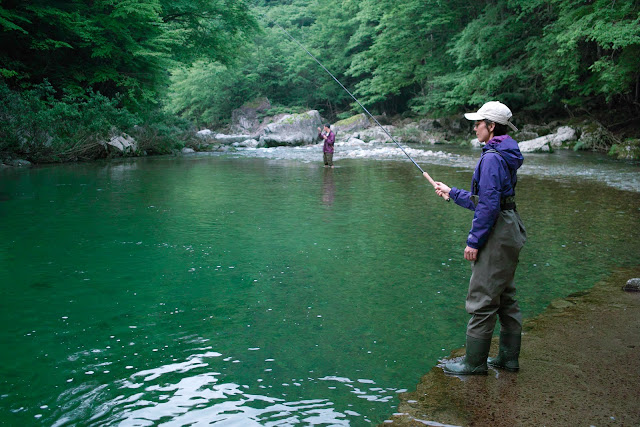
Some are large, slower rivers, these are just normally referred to with the general name “kawa/gawa” – there may be a more specific term, but I still haven’t learned it. The picture below was taken in Gujo soon after the ayu fishing season started. I’ll write more on ayu fishing later, but for now, suffice it to say it’s not tenkara! It’s done using a live “decoy fish”. It’s definitely a serious activity here. I may even call it “the bass fishing of mountain streams”.
Other streams are very steep, and the walls around it form a type of canyon. These are generally called “tani/dani”. These are the streams where people may do “shower climbing”, or sawanobori – interestingly, the activity is called “sawanobori”, because tani may or may not have water in it (it’s a canyon area), and shower climbing requires water, thus “sawanobori” is used. I helped take a group of kids on an outing to one of these streams, but no fishing allowed there. Next friday I’m scheduled to go explore a “tani” and will do some tenkara fishing. Actually, I’m supposed to catch lunch. Here’s the place I wish I had fished, but instead I enjoyed some awesome canyoning:
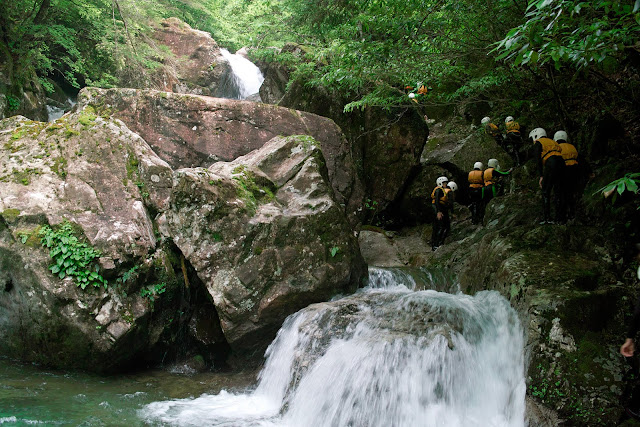
The fish here are just gorgeous, when I can see them I get excited about fishing again. In this area we can catch Iwana, and Amago. On the Japan sea side, one may find the yamame. Next week I have an outing scheduled with a local whose favorite stream is a couple of hours away and we can catch yamame.
This is a picture of a Iwana, my best fish on this trip. It’s not the largest fish one can catch here; last week on the ryokan I visited, the owner had a beautiful mounted display of a 20.5inches (52cm) Iwana. The Fishing Center has a dried 25inch Iwana on their wall. Tenkara was also used to catch some large fish.

Here is an amago I caught on a “shiryu”, the term for tributary. Notice the small red spots, the differentiating mark between the amago and the yamame. I hope to have a picture of yamame next week.

Visiting the tamo shops
Early this week I looked at my calendar and Wednesday was a free day – I have been busier on this trip than I had ever imagined. So, I decided to revisit the tamo shops a couple of hours away from here. This was my third visit. I actually had to return before I leave to pick up a couple of pre-ordered mesh bags for my nets. But, mostly I was excited to look at all the nets I could before the end of my trip.
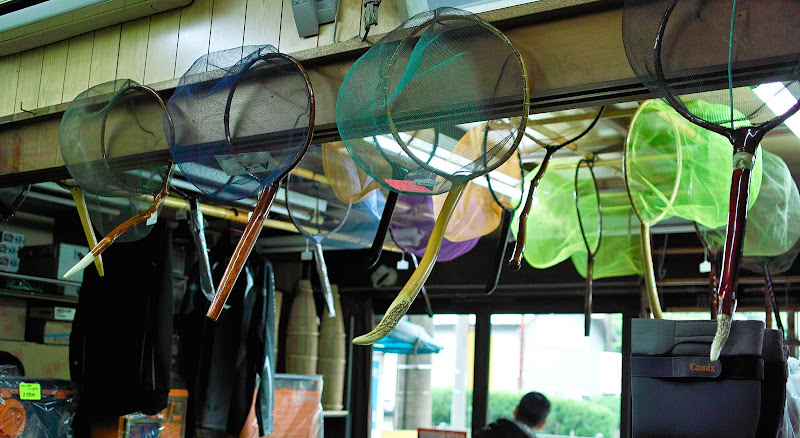
On the drive over, I noticed the same mountains I had seen when driving with Chris a couple of weeks ago. This time I found a better viewing spot and was able to setup my tripod for a more stable shot and some video.
Last year Dr. Ishigaki took me to visit one of the stores, where I fell in love with tenkara nets. Then, a few weeks ago Eiji Yamakawa and his friends came to this area, but as it was raining very heavily on our second day they decided to visit the tackle shops instead of going fishing, I tackled along. This time I wanted to go on my own. I wanted to take my time in observing the style of different net makers and I wanted to talk to the owners of the stores with no rush, no time to go back, and without feeling like I’m taking someone else’s time. Furthermore, this would be excellent Japanese practice.
My Japanese is still very crude, but I’m finding that on the topic of fishing I have been holding decent conversations, being able to ask the questions I want (even if sounding like a Tarzan), and understanding most of the responses. Sometimes I still count on my iPhone, which in Japan has become an expensive dictionary, though I’m relying on that less and less. Also, I do keep a small moleskin notebook and pen with me at all times and take note of new words and refer to ones I learned before. I have had numerous hour+ long conversations here, and those have been some of the most fun (though challenging) experiences in Japan. There is something about living on the country-side, where people seem open to taking their time in conversing with a stranger, arriving at common grounds and sharing common experiences. Whereas most encounters in big cities seem dictated by a one-hour time block, here I have sat for a cup of coffee and talked with people with no pre-allocated amount of time. Sometimes conversations are quick, other times 3 hours long, nonetheless each is a big opportunity to learn about 10,000 new things.
(by the way, though tenkara is mostly for smaller fish, if you still think it is only for the very small fish, take a look at the mounted fish on Shimizu’s wall, fish of that size or larger are a common decoration on walls of businesses in this area)
The first tamo shop I stopped at is owned by Shimizu-san. By far my favorite store and where I got my first net last year. A few weeks ago when we tried to stop by they were closed, so I was happy to find his store opened on this visit. Shimizu-san’s store has been around for about 40 years and was previously owned by his father. At this time of year, ayu fishing season is starting and the river across the street from his store was filled with ayu anglers (more on this later). A couple of times fishermen came in dressed in their neoprene waders to talk to Shimizu, as I admired each of the nets he had on display. This year’s collection of nets from different makers was nothing short of extraordinary. The nets were much more expensive than they had been last year, but each of the nets was of very high quality. Also, his store only stocked kaya-tree nets this year, as opposed to nets made from other trees like the “momi”. He says kaya nets are the best and he’s not carrying nets from other woods this year. He and I had a good conversation. I didn’t meet him last year, but he said his wife had mentioned meeting me last year.
Then, I revisited another store where I had stopped a few weeks earlier. I actually had to return to the area before I left since I had pre-ordered 2 custom mesh bags from the maker. I had asked if they had any mesh bags to sell, but they didn’t, preferring instead to use the bags for their own nets. However, he agreed to prepare a couple for me and have them ready within about 10 days. So, I stopped there and picked them up for my upcoming kaya nets. Here’s a picture of the maker about 30 years ago, this picture hung on the wall:
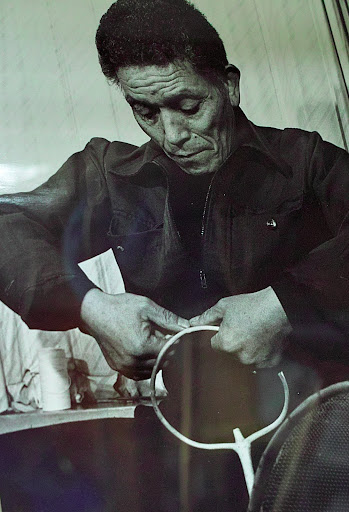
Fuji no Hana 藤花Originally posted on June 10, 2010

There will be some new content for those of you who have been reading our blog for over a year. I do not want to keep duplicating entries, but, this one is a timely one for our area of Japan.
Last year I talked about how the Fuji flower (藤花, fuji flower, wisteria japonica), is considered to be the “tenkara flower”. This is because when the fuji flower’s blossom is an indication that fishing is good. I have been in Japan for over 15 days now. Sadly, the fishing in this area has been very poor, and, tellingly, until yesterday I had not noticed the Fuji flowers in the area I’m staying. Today, they seem to have bloomed and are starting to appear in many places. While I still suspect the fishing here won’t improve all that much (I’ll talk some other time about the poor management of fisheries in Japan), the almost overnight flower’s blossom is a sign for hope.
Originally posted on June 10, 2010, after fishing in Japan at this exact time of year last year.
This time of year is considered the best time for tenkara fishing in the mountain streams of Japan. One of the main indicators of this is the Fuji hana (藤花, fuji flower, wisteria japonica). The fuji flower is commonly found near streams in Japan at this time of year, and when it’s blooming it’s said to be tenkara fishing time. So, I’ll call the fuji flower, the tenkara flower. Now we need to find one for tenkara in the US.
The character for the fuji flower (藤) is the same character as Fujioka-san (藤岡), so they joke that’s his flower. This is the fish he caught just about an hour earlier:
Fujioka-san with a nice Iwana
One morning I was able to get very close to the fuji flowers, they tend to be found a bit high, but a few hours before I was able to I had dunked my camera’s lens, a big SLR lens, into the water as I landed a fish. It’s what I call my karma neutralizer. I didn’t realize it until later, but the picture I took was a bit foggy. Luckily I was able to get back there before the trip was over and take a better picture.

Tenkara Japan A quick preview
Sakasa Kebari tied by Amano-sensei, free-hand, with no tools and eye-less hooks. Sakasa Kebari hold quite a esteem here.
It’s been 12 days since I arrived in Japan seeking to learn more about tenkara and experience the mountain fishing culture of Japan. This is my third visit to Japan, and each time I continue to learn more and more about tenkara. Who knew such a simple method of catching food would have so many subtleties to keep me coming back!
Tenkara and Tenkara USA for me are much more than selling fishing rods and other items; I’m very passionate about sharing the method of fishing with you. I’m happy to be writing this and working on videos, pictures and other content from my new room overlooking the mountains of Gifu. I will try to find time between fishing and hanging out with the people from the area to share what I learn on the blog. Rainy days like today are perfect for that.
After about a week of travelling, I have now been settled in what will be my home for the next month and half in the small mountain stream village of Maze, on the Maze River in Gifu, Japan. It’s a beautiful, idyllic setting. Very inspiring. Out of 12 days in Japan I think I have fished on 8 of them. I can’t say enough about how beautiful the streams here are, I absolutely love them. Crystal clear water, emerald gems with movie-like settings of cedar forests and mossy rocks.
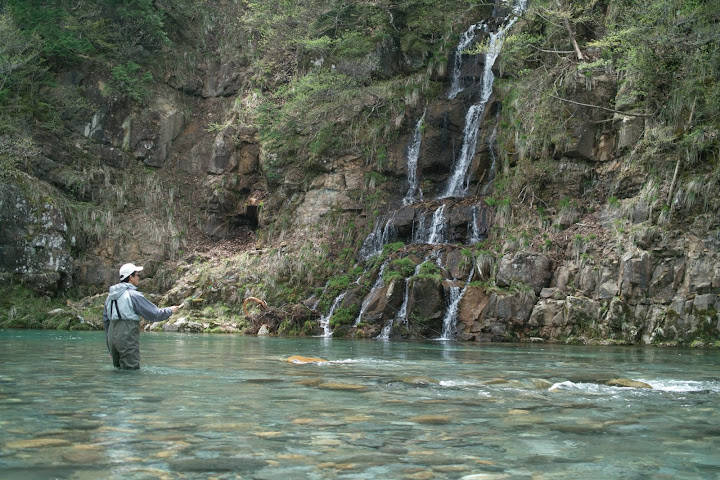
Chikara fishing an idyllic stream, great fishing, poor catching 😦
But,unfortunately, I’m quickly acquiring a new appreciation for the streams in the US and sometimes I wish I could mix the best of both worlds, where regulations, and stream management and keep-limits would make the rivers here more productive. Rivers don’t have a keep-limit and the concept of catch-and-release is virtually unknown – though I revisited the Itoshiro River, a very productive C&R river about 1 1/2 hours from here. Out of the many stretches of streams I have fished in this area, few showed much sign of life. I did catch fish just about every day, but it was hard work! Conditions are good, insect life very abundant, but the fish seem to be mostly gone. A shame, but we’ll see what I find deeper in the forests.
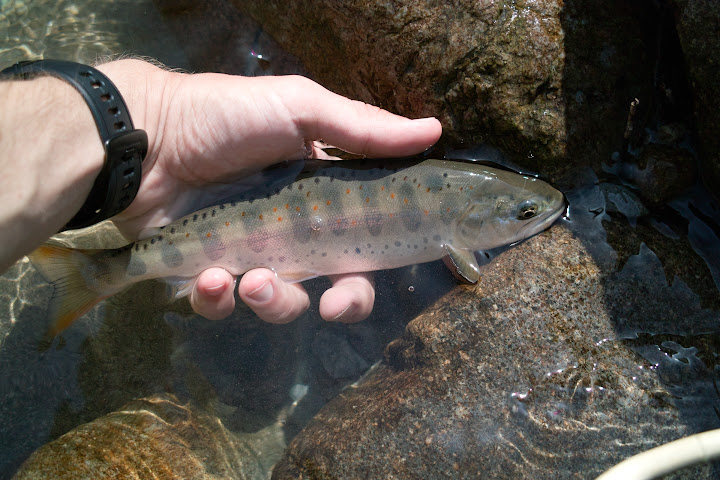
A beautiful example of an Amago, a native, though seemingly rare fish.
My host, Rocky Osaki, manager of the Mazegawa Fishing Center, and his wife Ikumi, have taken great care to introduce me to the community of both anglers and non-anglers in the region. I have been blessed to be invited into numerous homes where I soak all I can about tenkara, fishing culture and other aspects of life here. And, of course, have been soaking on the local onsen every chance I get.
A local kid whom I just had to nickname “Sanpei”, he doesn’t seem to mind.
This weekend there was a wonderful event here. 3 tenkara masters, and I do not use that word lightly, taught a course on tenkara to a group of about 15 people. I spent most of my time with Amano-sensei (more on him later, but quite a character and a most skilled tenkara angler).From each of them, as well as other very experienced tenkara anglers, I have learned more about tenkara.
Tenkara fishing course
Ah, and today I was featured in the regional newspaper, in an article talking about the event and the presence of Tenkara USA there:
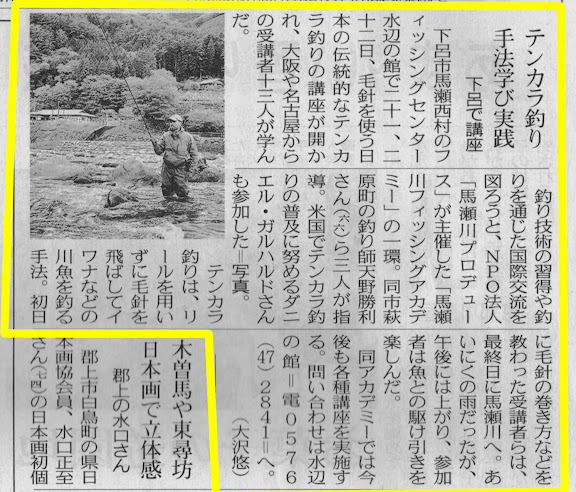
Checking in from Japan A view of where I'm staying
Not much writing on this blog post today.
But, in case anyone is curious, here’s a panorama I did yesterday with my iPhone of the Mazegawa Fishing Center. This is the place I’m spending almost my entire time. It’s one of the coolest places on earth to spend 2 months. A fishing center, with access to canyoneering gear, a tenkara-perfect river right in front of it and a hot-spring onsen just up the hill. I’ll try writing more later. Now, back to studying Japanese before I head out to fish some more.
Hope most of you can see this 360′ view of the place. You may need special software for it and I apologize for that.
Here’s the location of where I’m staying, notice the abundance of mountains and streams in the area!!! The town I’m staying doesn’t have a convenience store, nor traffic lights. It’s very quite, and gorgeous. Mountain view galore, and streams in abundance:
Interview with Misako Ishimura
Misako Ishimura is the co-author of the book Tenkara – Radically Simple, Ultralight Fly-fishing , and she agreed to give us an interview, sheding a bit of light on her background and connection with tenkara.
Misako, you have greatly contributed to helping introduce tenkara to the United States. I think it was some type of sign that you were working on the “Made in Japan” exhibit for the Catskills Fly Fishing Center and Museum right at the time I was working on launching Tenkara USA. Almost exactly one month after Tenkara USA launched, the highlight of your exhibit was a demonstration on tenkara by Dr. Ishigaki who came from Japan for the event. Now, 2 years after tenkara was first introduced to the US, you worked with Dr. Kevin Kelleher on a book which will open the doors to fly fishing for many people.
TUSA: Can you tell us how you first discovered tenkara and how long you have been practicing it?
Misako: I started to research Japanese fly fishing history in year of 2000 because many anglers from the other countries at FIPS Mouche World Fly Fishing Championships have been asking me about Japanese fly fishing. During my research in Japan, I discovered tenkara. It gets my interest since tenkara is the way to catch beautiful Japanese trout. Every time I’ve been to Japan, I collected information about tenkara little by little. Finally I had a chance to learn actual tenkara fishing from Dr. Ishigaki in the mountain stream in Gifu prefecture in June, 2008. Since then, about four years, I have been practicing it.
Utah, indeed a tenkara-perfect state
Recently two of our customers, Erik and John, started organizing a tenkara gathering in Salt Lake City, Utah. I had been looking forward to returning to the area. The last time I had been there I spent a week fishing every day after work. The mountain stream fly-fishing in the area is phenomenal. That was pre-tenkara, and I had been looking forward to tenkara fishing in those mountain streams. I knew they would be tenkara-perfect. Indeed they were.
Below is a slideshow of the 4 days I spent in the area. Every day as perfect as it could be. On Thursday I arrived at the airport in late afternoon, checked into my hotel, and headed to one of my favorite streams. I called Erik up, and he was already there – mind you we had no plans to meet that afternoon, but we had a blast fishing together. Friday was a nice repeat, and it included John. Awesome company in small stream fishing. On Friday night I gave a talk at Western Rivers Fly Shop in SLC. They don’t currently carry our gear, but were very welcoming and eager to learn more about tenkara and have their customers also learn about it. The talk was followed by a great dinner at a sushi restaurant not far from the shop. Saturday we resumed the “talk” with on-stream demonstrations. We fished all day, caught some nice fish. More fishing Sunday on one of the most gin-clear streams I know. On Monday I headed up to Logan to meet with our dealers in the area. Round Rocks brought in a great crowd, many already avid tenkara anglers. The rivers were completely out of control and it was raining but I still gave the on-stream demonstration, on the stream that runs right behind their store. It was very cool to teach real tenkara to people that were so used to using it similarly to western fly-fishing.
Today I came to Bozeman and already have some great stories, which I hope to share soon, including tenkara fishing in the middle of an unexpected snow blizzard today. Tomorrow morning I’m heading on a 2-day backpacking trip with Ryan Jordan, founder of Backpackinglight.com. Definitely looking forward to this and to sharing it all with you. All in all a great time. Enjoy the pictures.
https://picasaweb.google.com/s/c/bin/slideshow.swf
Tenkara in the media Ralph and Lisa Cutter and John Gierach embrace tenkara
We are absolutely ecstatic this month! Tenkara has reached the mainstream through the words of 3 of the most respected anglers and writers in the US: Lisa and Ralph Cutter and John Gierach. These articles were published in what I have come to perceive as two of the most progressive magazines in the industry: California Fly Fisher, and Fly Rod and Reel. these magazines have been ready to tell their readers about tenkara, a new development in the US, which I think proves their editorial integrity and that they are concerned with telling their readers what is new in fly-fishing as opposed to just pushing their advertisers’ wares. Kudos to these two magazines.
Ralph and Lisa Cutter write about tenkara for California Fly Fisher
Ralph & Lisa Cutter wrote a great article on their first experiences with tenkara for California Fly Fisher, with a beautiful illustration of a mayfly landing on a bamboo stalk done by Lisa. Getting to meet Ralph and Lisa was quite awesome in itself. I had known about the Cutters’ work for a long time, and always suspected they would probably enjoy learning about tenkara. One day, suddenly and unexpectedly, I received an email from them. Ralph says that Yvon Chouinard was visiting with them for a couple of days, and Yvon kept talking about tenkara. With so much “tenkara this, tenkara that”, Ralph couldn’t resist and got in touch. It just so happened I was in the Sierras and would be going past their place on my way back home and also had some rods in the trunk of my car. I personally delivered the equipment, and gave them a brief lesson. As they attest in their article, there is more to tenkara than is first expected, ” the few videos and descriptions of tenkara I had seen prepared me for a lesson in dapping and high sticking.However, when Daniel made a crisp, tightly looped cast and hit a fist-sized pocket 30 feet away, I was incredulous. His line, nothing more than 18 or 20 feet of 16-pound fluorocarbon leader tied to a few feet of 5X tippet, was effortlessly lifted from the water by his 13-foot rod. Only the fly and a few inches of tippet remained touching the film. It was a perfect dragfree presentation . . . more perfect than any Western fly rod could ever approach in that situation.” A couple of weeks later my friend Marty and I had the pleasure to fish with them for a couple of days, what an awesome couple of people! My favorite quote from their article, ” I can’t imagine ever approaching a small stream with conventional fly gear again.”

Ralph and Lisa Cutter on a rest at midday by the Truckee River – all their gear between them.
John Gierach writes about tenkara for Fly Rod and Reel magazine
For the many months since I met John Gierach and Ed Engle for a few days of fishing in Colorado, I have been anxiously anticipating John Gierach’s words on tenkara. I had been longing to see his eloquent and characteristic writing illustrating tenkara to his readers. And, I was not at all disappointed to read his 4-page article for Fly Rod & Reel magazine, which is currently arriving to subscribers and should be in newsstands soon. Through his article I was able to relive my experiences with two anglers I have admired for a long time, Gierach himself and Ed Engle. In turn they were able to share their first-hand insights on tenkara with their readers. Ed’s article, published right after the trip for the Daily Camera can be found here. The article did tenkara great justice. My favorite quote in the article, “I’d sometimes giggle out loud at the long reach I had and the beautiful drifts I was getting in normally difficult pocket water.”
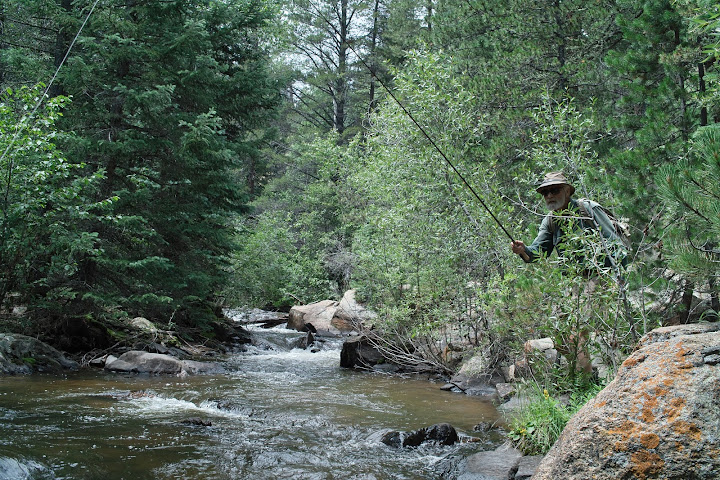
John Gierach hitting a nice pocket in a small mountain stream.
I think the Cutters and Gierach’s readers deserved to learn about tenkara. After all they often talk about mountain stream fishing, and how could you ignore tenkara when that is one of your favorite kinds of fishing? It’s awesome that they have been able to see why tenkara is here to stay.
About Tenkara
What Is Tenkara?
Tenkara is the traditional Japanese method of fly-fishing, which uses only a rod, line and fly.
Tenkara is a category of fly-fishing particularly well-suited for fishing small streams and for backpacking. It’s a very effective, simple and enjoyable method of fly-fishing small streams.
The basic concept:
Tenkara is primarily used for small-stream fishing. It is particularly effective for fishing pocket water and faster flowing streams. Some of the main advantages are its simplicity, the very delicate presentations with the light line, the ability to hold the line off the water and a fly in place on the other side of a current, precise casting, and greater control of the fly.
Only rod, line and fly are used. The line is attached directly to the tip of the rod using a girth hitch, and tippet is attached to the end of the tenkara line (total line length will be about 1 – 2 ft longer than the rod) . Like in western fly-fishing the line propels the weightless fly foward and there is a fly-casting technique involved (just a bit slower, and with a shorter casting stroke). Landing a fish is very intuitive and similar to any type of fishing with a rod: one simply raises the rod high, and reaches for the fish.
